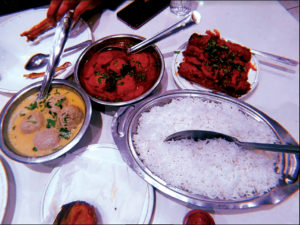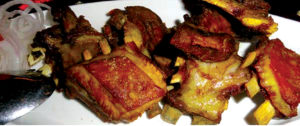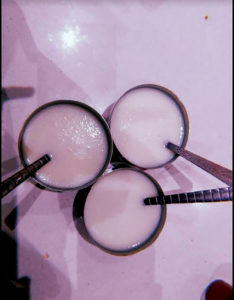Kashmiri cuisine is a blend of authentic ingredients, spices and tradition, surprisingly they can be found far from the valley — at relatively unknown places within the capital
Aghar Firdaus bar roo-e -zameen ast, hameen ast-o hameen ast-o hameen ast”
-Amir Khusrau
THE FAMOUS couplet translates to, “If there is a paradise on earth, it is this, it is this, it is this”. It was famously used by poet Amir Khusrau to describe the eternal and breathtaking beauty of Kashmir. Indeed Kashmir is majestic and a delight to all who love to explore the beauty of nature. The Valley famed for its handicrafts, embroidery and carpets also hosts another hidden gem: its mouth-watering cuisine, which speaks volume of its rich culture and tradition.
Finding authentic Kashmiri food outside the Valley is an uphill task. The spices and the ingredients used in Kashmiri cuisine are native to the Valley and give the food its traditional taste. Local spices like chillies, cockscomb, turmeric and saffron give it authentic flavours.

The preparation of food in the Valley is regarded an art and food is an important part of the locals’ lives. Multi-course meals traditionally comprise 36 courses which includes of meat-based dishes.
For people looking for a taste of Kashmiri cuisine outside the Valley there are many options in the capital. For that authentic experience head over to-
J&K Kashmir House, Chanakyapuri
J&K house is famous for its authentic Kashmiri delicacies and is a must-try for anyone who likes spicy food. The menu changes twice a day. Some of the best offerings on the menu include the mutton gushtaba, mutton rista, mutton roganjosh, mutton yakhni (a thin yogurt-based curry with mutton balls), mutton tabakhmaz, mutton kebab, and mutton shami kebab.
The kebabs here are delicate and succulent with the perfect measure of the spices. They are prepared by frying them perfectly in a light garnish of onions and green chillies. Mutton yakhni is another beautifully crafted delicacy, it has the wonderful aroma of a mix of cardamoms, cloves and cinnamon. The curry is thick and flavourful and tastes amazing with plain steamed rice.
Also the mutton tabakhmaz (fried lamb ribs) with milk, ghee and a mélange of spices is a must-try if you are a fan of Wazwan cuisine. It’s one of the most popular snacks of Kashmir.
Taking about dessert, the one that towers above the rest is phirni, a pudding made by boiling milk and sugar with rice, saffron and cardamom. The richness of the dessert is sure to leave you wanting more.

Ahad Sons food restaurant, Uday Park, New Delhi
Ahad Sons occupies the smallest of spaces behind a Mother Dairy booth in the Uday Park neighbourhood. A glimpse of the menu leaves you with rich promises of dishes from the paradisiacal state. Delicacies that you must try include the Gushtaba (pounded mutton balls cooked in curd gravy), Tabakh maaz (lamb ribs) and the Aloobukhar korma (a chicken gravy dish cooked with dried plums and spiced with kashmiri masalas).
Samavar, Greater Kailash, New Delhi
It is a nice, cosy-restaurant with a homely ambience where you can spend a relaxing evening. It offers authentic Kashmiri Mughlai dishes that are cooked to perfection and designed to delight the taste buds. Recommended dishes include Rogan Josh (a lamb curry made with spices like fennel seeds and dry ginger) with walnut chutney (soaked walnuts with green chillies, some black cumin seeds, yogurt and salt) and Kahmiri pulao with dry fruits — a delicious rice preparation where rice is cooked in milk and loaded with dry fruits and fruits.
The menu also includes Nadurchurma (a crunchy snack from the Valley made of lotus stems) , plain haakh (haakh, a dish of greens cooked with mustard oil, hing and dried red chillies) it is an important element of Kashmiri cuisine and is cooked in almost every household in the region, chuck wangun (khattay baingan) these are the foods that form the backbone of daily food in Kashmir. If Roganjosh is the star of the special occasion dishes, these are the stars of everyday meals.

Kashmir’s cuisine is unique not just in terms of spices — in particular fennel, hing, cardamom, and Kashmiri red chillies — but also in the way it is prepared. Nowadays the cuisine is catching on in being in different parts of the country – it is not only in Kashmir that the stem of the lotus flower is eaten in a variety of preparations. Now many high-end hotels and restaurants in Delhi serve these to their guests especially Kashmiris looking to quench satisfy their craving for home-cooked food.. You really don’t need to be a Kashmiri to eat and enjoy this cuisine.
So we think we had a great experience in exploring authentic Kashmiri food in Delhi and we were surprised to see the same atmosphere, taste and the simplicity that is the khasiyat (speciality) of our home.
So if you have not yet tried Kashmiri food, we suggest you to go for it because you are missing out a delicious experience. And if you are a Kashmiri, well, sorry for making you drool.





